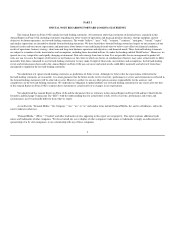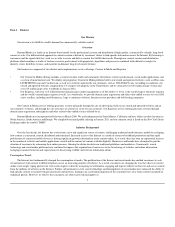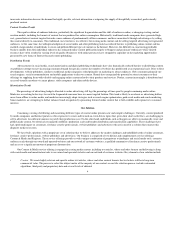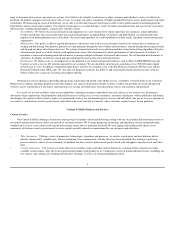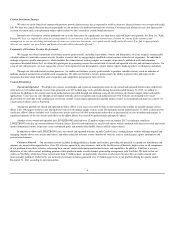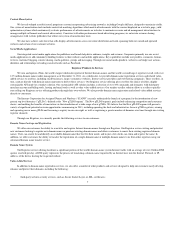Enom 2011 Annual Report Download - page 16
Download and view the complete annual report
Please find page 16 of the 2011 Enom annual report below. You can navigate through the pages in the report by either clicking on the pages listed below, or by using the keyword search tool below to find specific information within the annual report.
websites. The overall impact of these changes on the Company's owned and operated websites was negative primarily due to a decline in traffic to eHow.com
beginning in the second quarter of 2011.
There cannot be any assurance as to whether these changes or any future changes that may be made by Google or any other search engines might
further impact our content and media business. Any reduction in the number of users directed to our owned and operated websites and to our customers’
websites would likely negatively affect our ability to earn revenue. If traffic on our owned and operated websites and on our customers’ websites declines, we
may also need to resort to more costly sources to replace lost traffic, and such increased expense could adversely affect our business, revenue, cash flows,
financial condition and results of operations.
We base our capital allocation decisions primarily on our analysis of the predicted internal rate of return on content. If the estimates and assumptions we
use in calculating internal rate of return on content are inaccurate, our capital may be inefficiently allocated. If we fail to appropriately allocate our
capital, our growth rate and financial results will be adversely affected.
We invest in content and content formats based on our calculation of the internal rate of return on previously published content cohorts for which
we believe we have sufficient data. For purposes of these calculations, a content cohort is typically defined as all of the content we publish in a particular
quarter. We calculate the internal rate of return on a cohort of content as the annual discount rate that, when applied to the advertising revenue, less certain
direct ongoing costs, generated from the cohort over a period of time, produces an amount equal to the initial investment in that cohort. Our calculations are
based on certain material estimates and assumptions that may not be accurate. Accordingly, the calculation of internal rate of return may not be reflective of
our actual returns. The material estimates and assumptions upon which we rely include estimates about portions of the costs to create content and the revenue
allocated to that content. We make estimates regarding when revenue for each cohort will be received. Our internal rate of return calculations are highly
dependent on the timing of this revenue, with revenue earned earlier resulting in greater internal rates of return than the same amount of revenue earned in
subsequent periods.
We use more estimates and assumptions to calculate the internal rate of return on video content because our systems and processes to collect
historical data on video content are less robust. As a result, our data on video content may be less reliable. If our estimates and calculations do not accurately
reflect the costs or revenue associated with our content, the actual internal rate of return of a cohort may be more or less than our estimated internal rate of
return for such cohort. In such an event, we may misallocate capital and our growth, revenue, financial condition and results of operations could be negatively
impacted.
We face significant competition to our Content & Media service offering, which we expect will continue to intensify, and we may not be able to maintain
or improve our competitive position or market share.
We operate in highly competitive and still developing markets. We compete for advertisers and customers on the basis of a number of factors
including return on marketing expenditures, price of our offerings, and ability to deliver large volumes or precise types of customer traffic. This competition
could make it more difficult for us to provide value to our consumers, our advertisers and our freelance creative professionals and result in increased pricing
pressure, reduced profit margins, increased sales and marketing expenses, decreased website traffic and failure to increase, or the loss of, market share, any of
which would likely seriously harm our business, revenue, financial condition and results of operations. There can be no assurance that we will be able to
compete successfully against current or future competitors.
We face intense competition from a wide range of competitors, including online marketing and media companies, social media outlets, integrated
social media platforms and other specialist and enthusiast websites. Our current principal competitors include:
•Online Marketing and Media Companies. We compete with other Internet marketing and media companies, such as AOL, About.com and various
startup companies as well as leading online media companies such as Yahoo!, for online marketing budgets. Most of these competitors compete
with us across several areas of consumer interest, such as do-it-yourself, health, home and garden, beauty and fashion, golf, outdoors and humor.
•Social Media Outlets. We compete with social media outlets such as Facebook, Twitter and Google+, where brands and advertisers are focusing a
significant portion of their online advertising spend in order to connect with their customers.
•Integrated Social Media Applications. We compete with various software technology competitors, such as Jive
12


